Earlier this year my daughter shared this photograph of Susan Richardson Abbott and her obituary from a newspaper in 1909. I decided to see what I could learn about her in addition to the stereotypical “good old mammy” obituary. This is what I found.
Click any image to enlarge in another window.
Obituary
ABBOTT, Susan
The Brunswick Journal; Monday 18 January 1909
SUDDEN DEATH OF OLD SERVANT—For Many Years a Faithful Servant in Family of Judge Crovatt.
There will be genuine sorrow expressed by a very large number of white people when they learn of the death of “Mammy Sue,” who has been faithful servant in the family of Judge A.J. Crovatt for the past thirty years.
Everybody knew “Mammy Sue”; she had been so identified with the family of “her people” as to be one of them.
Born in Charleston, a slave, Susan Abbot [sic], as she was known, was brought to St. Simons Island and was the servant of the Hazzard family there.
At the close of the war, Susan became a member of the family of Col. C.L. Schlatter, the father of Mrs. A.J. Crovatt. After the marriage of Miss Mary Lee Schlatter to Mr. A.J. Crovatt, “Mammy Sue” went with her young mistress and was the nurse of three children of Judge and Mrs. Crovatt.
As the widow of a soldier in the Federal Army during the war, Mammy Sue was awarded a pension by the government. Though her husband fought on the Federal side, Mammy Sue staid [sic] with her “own people.”
Famous as a cook, devoted to the interests of those with whom she had been so many years, the death of Mammy Sue removes another of the rare ante-bellum negroes.
Her illness was of only a few hours duration; the young daughter of the house, Mary Lee Crovatt, had gone to see the old woman at ten o’clock to give her a cup of tea; Mammy did not complain of being ill, and had been about her usual duties all day yesterday. Though eighty years of age, Mammy Sue was remarkably active, and was in full control of all her faculties. At one o’clock another of the servants heard the old woman calling, and Miss Crovatt and her brother went to the room in the servant’s house. When the door was opened, Mammy Sue was unconscious and died with(in) a few minutes.
Four children survive, Thomas and Joseph Abbot and Eliza Cuyler, all of whom live on St. Simons. Another son, Randolph Abbot, being in Charleston (note: no Randolph found). The body will be carried to St. Simons where it will be interred tomorrow.
FUNERAL OF MAMMY SUE HELD ON ST. SIMONS
The body of Susan Abbott, or “Mammy Sue” the aged servant of Judge A.J. Crovatt, was carried to St. Simons this morning for interment.
Services were held last night in the First African Baptist Church, of which church, Mammy Sue had long been a member. The Brunswick Journal; Tuesday 19 January 1909; pg. 1
______________________________
Almost two hundred years ago Susan Richardson Abbot was born into slavery on the plantation of Thomas Boone in Charleston, SC. After Boone died 28 October, 1831, his wife began selling off land and people.
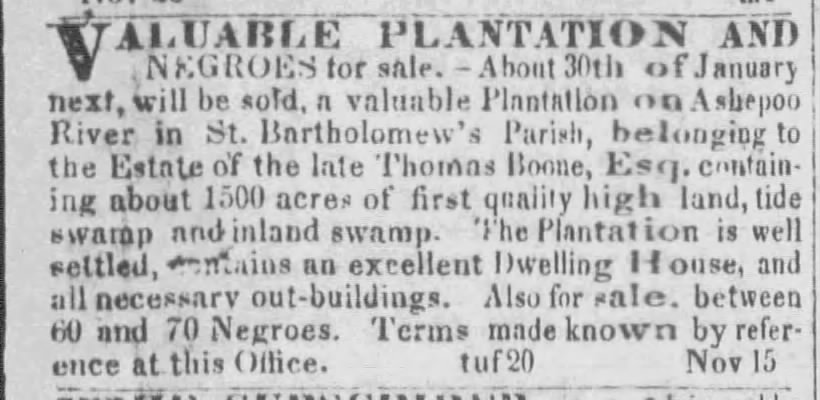
On 13 December, 1831, Mary Boone sold eleven people, including Susan, her mother Chloe and her brother Richard, from her husband’s estate in Charleston S. C. to William W. & Mary Hazzard.
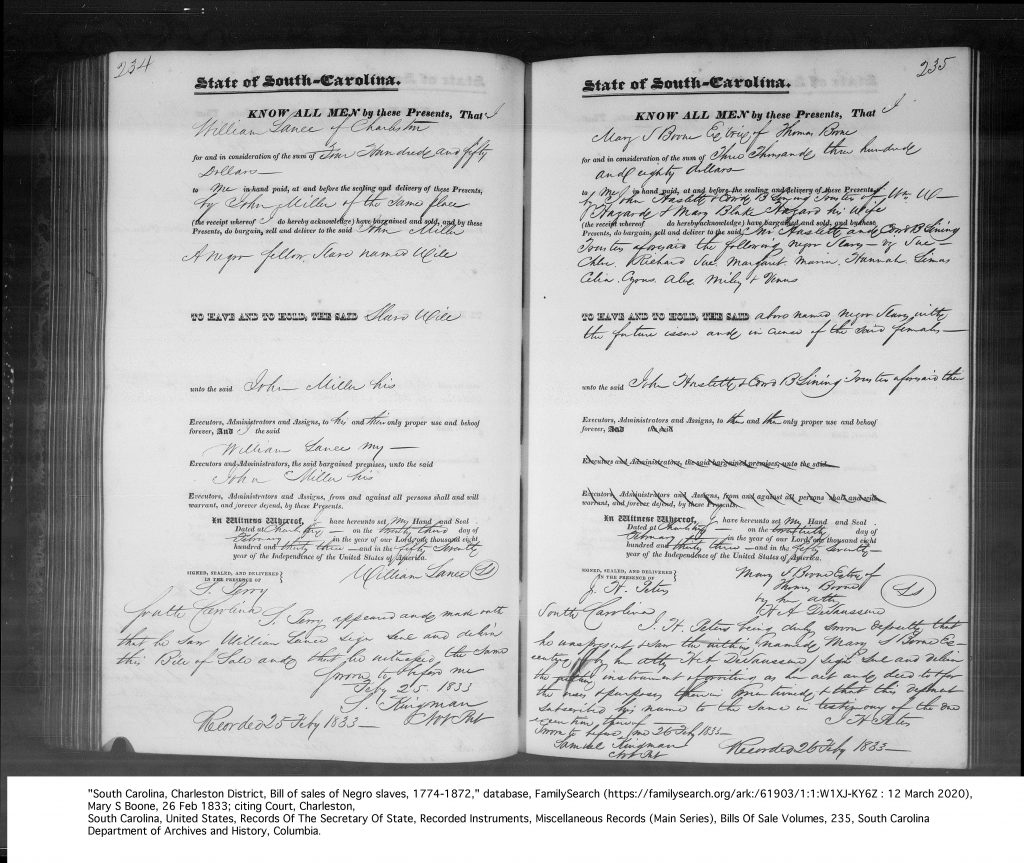
State of South Carolina
KNOW ALL MEN by these Presents, that Mary S Boone executrix of Thomas Boone for and in consideration of the sum of three thousand three hundred and eighty dollars to me in hand paid, at and before the sealing and delivery of these Presents by John Halsett & Corro B Lining trustees of Wm W Hazard & Mary Blake Hazard his wife (the receipt whereof do hereby acknowledge) have bargained and sold and by these Presents, do bargain, sell and deliver to the said Mr. Hazlett and Corro B Lining trustees aforesaid the following negro slaves – viz Sue – Chloe, Richard, Sue, Margaret, Maria, Hannah, Limas, Celia, Cyrus, Abe, Mily & Venus
TO HAVE AND TO HOLD, THE SAID above named negro slaves with the future issue and increase of the said females-unto the said John Haslett & Corro B Lining trustees aforesaid them…
In Witness thereof, have herunto set my Hand and Seal
Dated at Charleston – on the twenty sixth day of February in the year of our Lord one thousand eight hundred and thirty three and in the fifty seventh year of the Independence of the United States of America.
Signed, sealed and delivered in the presence of J. H. Peters, South Carolina
Mary J Boone executrix of Thomas Boone by her atty H A Devaussure
Recorded 26 Feb 1833.
___________
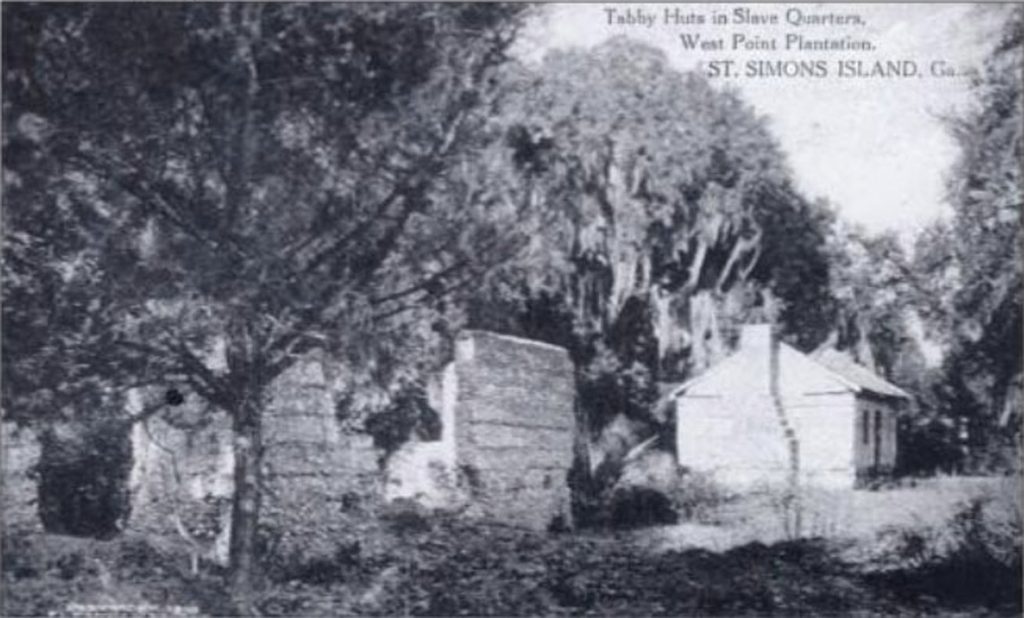
William Wigg Hazzard was one of fourteen large slave holders on St. Simons Island. The much prized Sea Island Cotton, was grown on their plantations. Long staple-cotton had a different culture than the cotton grown inland. It required more hand work. In 1810 Hazzard enslaved 53 people. By 1860, he enslaved 93. They were housed in 16 slave dwellings, making a little over 5 people per dwelling.
The housing was built using tabby, composed of the lime from burned oyster shells mixed with sand, water, ash, and other shells. The buildings, about 18 ft x 18 ft, consisted of one room. A fireplace at one end, was used for cooking and heat in cool weather.
Furnishings would have been minimal. Blankets were given out once every few years. Food and clothing rations were sparingly distributed. They may have been supplemented by gardening, hunting and fishing in the time not taken up by work.
Susan Richardson Abbott’s husband, Randolph Abbott, was enslaved on the plantation of Captain Charles Stephens, located next to the Hazzard’s plantations. Stevens made his money through shipping.
Randolph and Susan’s oldest child, was born in 1855, She was named Betsy. Over the next eight years five more children were born. Daughter Eliza was born in 1857. Son Bristol was born in 1858. Son Lewis was born in 1859. Son Thomas in 1861.
Susan Abbott and her husband were probably among the founders of the First African Baptist Church which was organized by enslaved people in their quarters below is the description From the church website.
The First African Baptist Church was organized at Pike’s Bluff Plantation in the year 1859. Members of this African American congregation traveled from all around the island to attend worship services every Sunday. The early pioneers worshiped in a little tabby church located near their quarters at West Point Plantation…
In December 1862, Susan Abbot’s husband, Randolph Abbott, joined the United States Colored Troops on St. Simon’s Island. At that time she was pregnant with the sixth child. Joseph, who was born in January of 1863, the same month his father was mustered into the USCT. He served for three years. On January 31, 1866 he was mustered out in Charleston, SC.
Civil War and Beyond
from the New Georgia Encyclopedia.
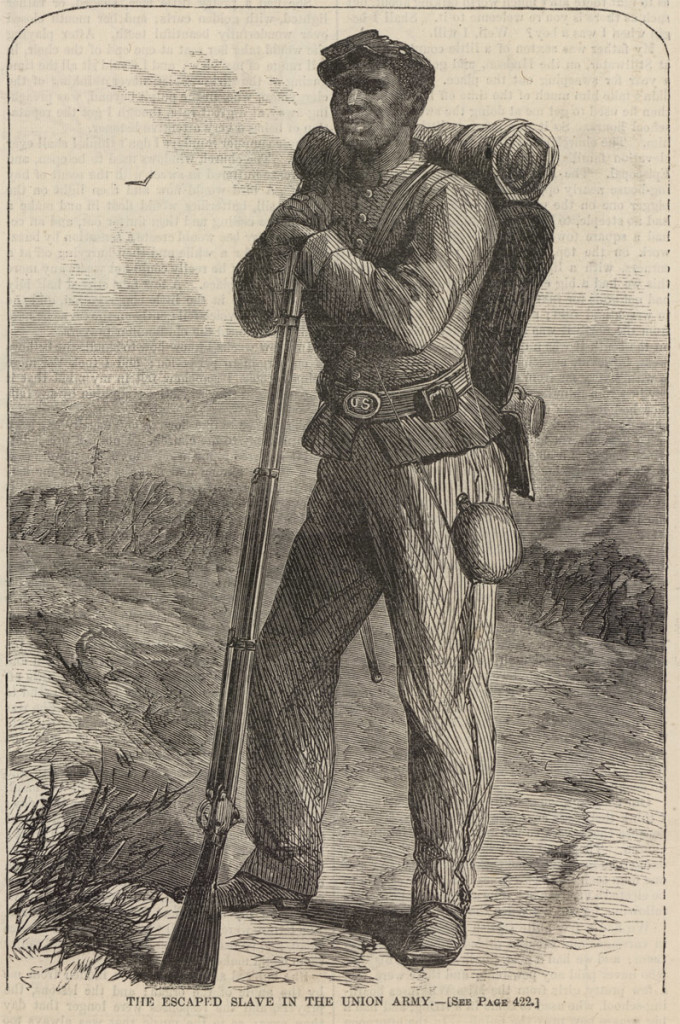
The outbreak of the Civil War in 1861 put a sudden end to St. Simons’s lucrative plantation era. In January of that year, Confederate troops were stationed at the south end of the island to guard the entrance to Brunswick Harbor. Slaves from Retreat Plantation, owned by Thomas Butler King, built earthworks and batteries. Plantation residents were scattered—the men joined the Confederate army and their families moved to the mainland. Cannon fire was heard on the island in December 1861, and Confederate troops retreated in February 1862, after dynamiting the lighthouse to keep its beacon from aiding Union troops. Soon thereafter, Union troops occupied the island, which was used as a camp for the formerly enslaved. By August 1862 more than 500 former slaves lived on St. Simons, including Susie King Taylor, who organized a school for freed slave children. But in November the ex-slaves were taken to Hilton Head, South Carolina, and Fernandina, Florida, leaving the island abandoned. After the Civil War the island never returned to its status as an agricultural community. The plantations lay dormant because there were no slaves to work the fields. After Union general William T. Sherman’s January 1865 Special Field Order No. 15 —a demand that former plantations be divided and distributed to former slaves—was overturned by U.S. president Andrew Johnson less than a year later, freedmen and women were forced to work as sharecroppers on the small farms that dotted the land previously occupied by the sprawling plantations.
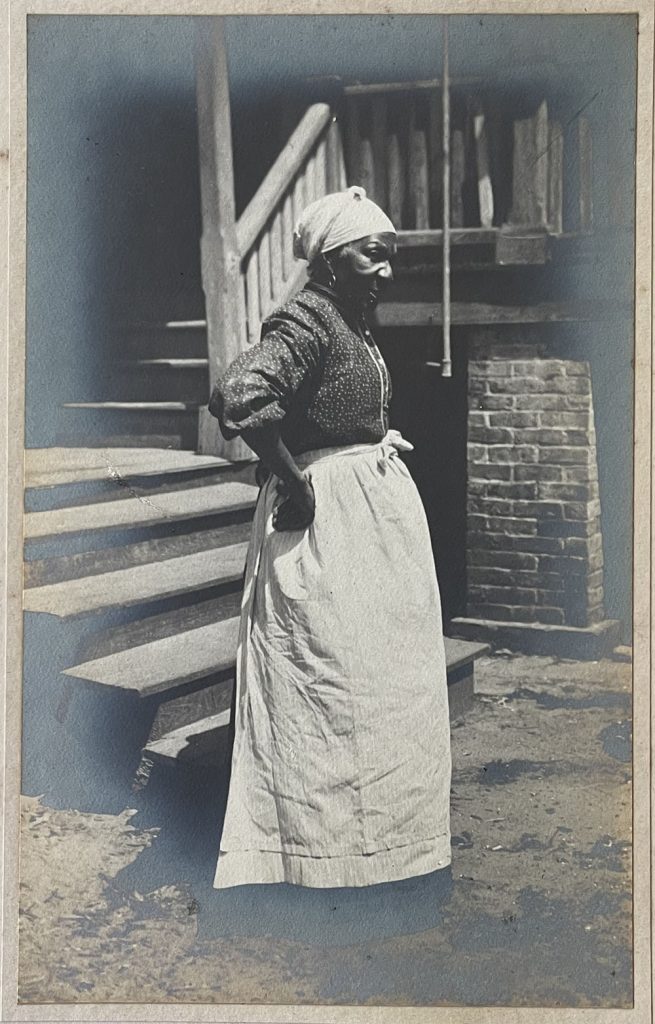
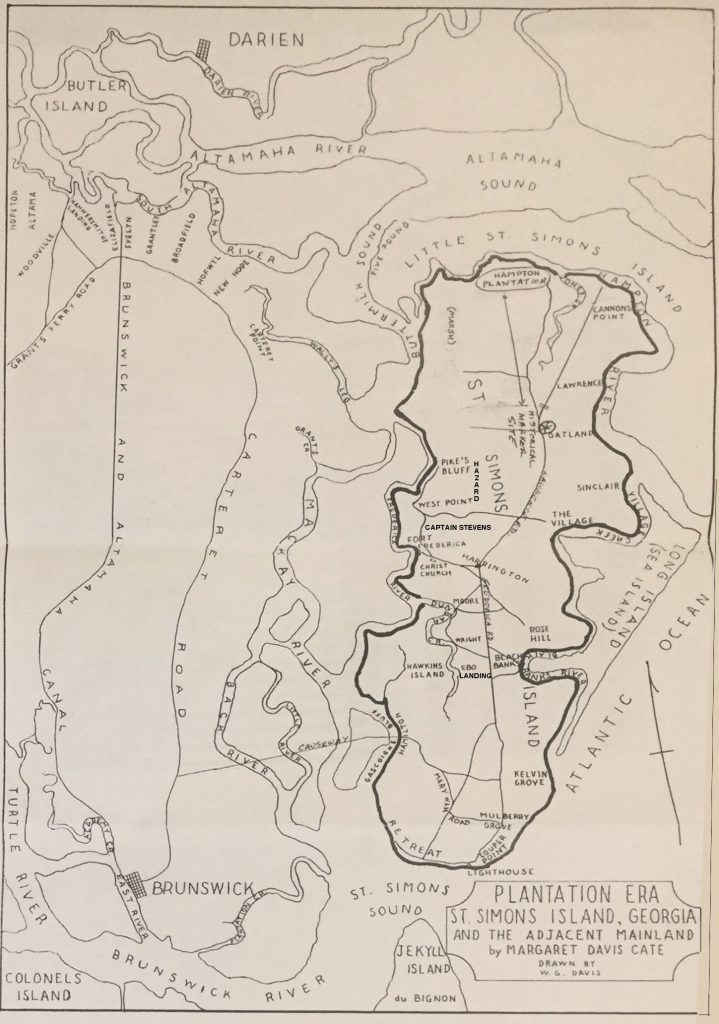
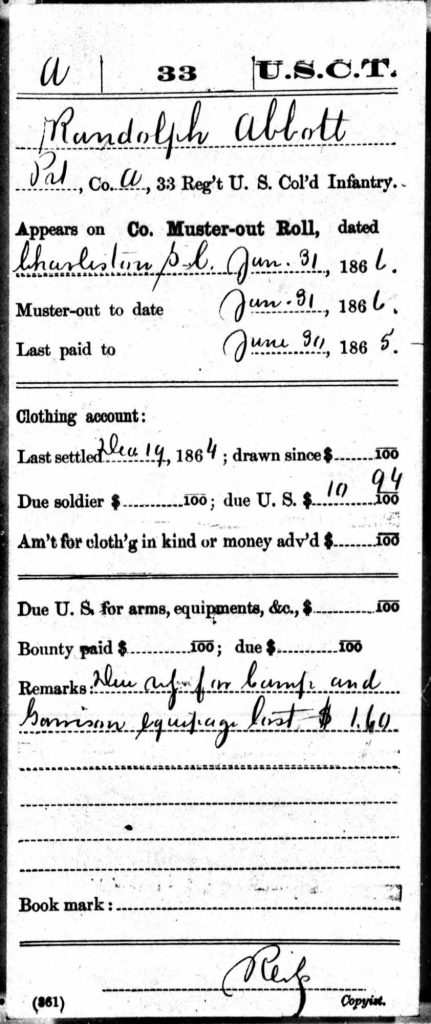

Incredible read!
Thank you Wendy. So good to see you here.
I’m so glad you’re telling her story. It’s fascinating that there’s so much to be learned. I notice in her obituary she was called a “servant” to the Hazzard family. Bit of a misnomer, that. I look forward to reading the next installment. I hope Facebook shows it to me.
I hope to publish it later today, so check back tomorrow if fb doesn’t mention it.
Yes, I noted that too. Arghhh. In spite of it, there were a lot of clues to follow up in that obit.
Is the Eliza mentioned the same person as your title “Finding Eliza?” Such detailed research.
No. None of these people are related to me at all. I just wanted to find the rest of Susan Abbott’s story.
Thank You so much for sharing GREAT read on Susan Abbott life and journey.
Thank you for reading and commenting!
Wow, Kristin; what an amazing obituary! I know it assisted you in the completion of this wonderful research. Congrats!
It did!
Great read!
Thanks Jan! Good to see I didn’t lose all my readers during my recent lack of posts!
As usual, whether or not you realize it, you’re teaching the rest of us how to PROPERLY treat history, and not just our family history. You’re not just my big sister; you’re one of my greatest heroes. Thanx!
Thanks Paul! High praise from a serious historian.
Excellent history behind the life of one woman…finding so much that happened on St. Simons Island, as well as the always difficult history of Reconstruction. Thanks for making all of this available to us.
I learned so much about St. Simons Island while researching her because I went to so many other sources that were only connected by being in the same place and the same history as the place she was.
A rare moment in history. Thank you! I can’t wait to read part 2.
Thank you Phyllis. I just posted part 2.
Thank you so much for this story and your wonderful research! My grandmother was born a slave in Charleston, SC. This story brings her to life for me! God bless you.
That’s amazing! I’m glad it touched you.
Thank you so much for sharing your research. I arrived at your site while looking for new information on Peter Joseph and his family.
I can’t figure out who Peter Joseph is, help me out!